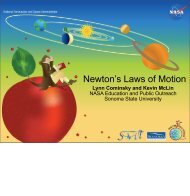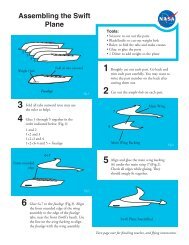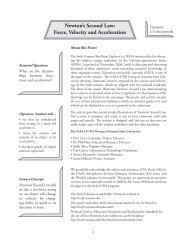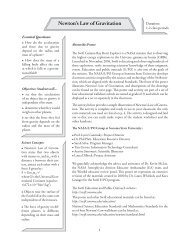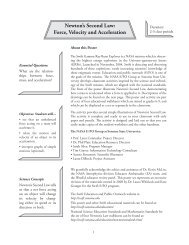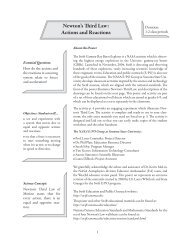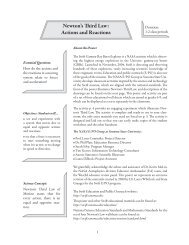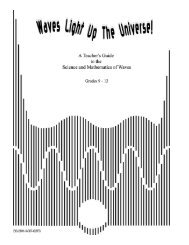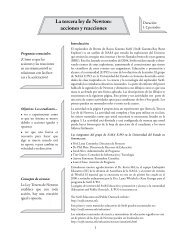Newton's First Law: - Swift - Sonoma State University
Newton's First Law: - Swift - Sonoma State University
Newton's First Law: - Swift - Sonoma State University
- No tags were found...
Create successful ePaper yourself
Turn your PDF publications into a flip-book with our unique Google optimized e-Paper software.
Duration:1-2 class periodsNewton’s <strong>First</strong> <strong>Law</strong>:Inertia and Unbalanced ForcesEssential Questions:What are the properties of inertia?How do common experiences with unbalanced forces help us to understand Newton’s <strong>First</strong> <strong>Law</strong>?Objectives: Students will…see that an object at rest remains at rest unless an unbalanced force acts on itsee that an object in motion will remain in motion unless acted upon by an unbalanced forcesee that an object in motion will change that motion if acted upon by an unbalanced forceScience Concept:Newton’s <strong>First</strong> <strong>Law</strong> of motion states that a body at rest will remain at rest unless acted upon by an unbalancedforce. It also states that a body in motion will maintain that motion, in the same direction and with the samespeed, unless acted upon by an unbalanced force.About this PosterThe <strong>Swift</strong> Gamma-Ray Burst Explorer is a NASA mission which is observing the highest energy explosions in theUniverse: gamma-ray bursts (GRBs). Launched in November, 2004, <strong>Swift</strong> is detecting and observing hundreds of theseexplosions, vastly increasing scientists’ knowledge of these enigmatic events. Education and public outreach (E/PO) isone of the goals of the mission. The NASA E/PO Group at <strong>Sonoma</strong> <strong>State</strong> <strong>University</strong> develops classroom activitiesinspired by the science and technology of the <strong>Swift</strong> mission, which are aligned with the national standards. The front ofthe poster illustrates Newton’s <strong>First</strong> <strong>Law</strong>. Descriptions of the drawings can be found on the next page. This poster andactivity are part of a set of four educational wallsheets aimed at grades 6-9; they can be displayed as a set or separately inthe classroom.The activity provides a simple illustration of Newton’s <strong>First</strong> <strong>Law</strong>. The activity is complete and ready to use in yourclassroom; the only extra materials you need are listed on page 6. The activity is designed and laid out so that you caneasily make copies of the student worksheet and the other handouts.The NASA E/PO Group at <strong>Sonoma</strong> <strong>State</strong> <strong>University</strong> is:• Prof. Lynn Cominsky - Project Director,• Dr. Phil Plait - Education Resource Director,• Sarah Silva - Program Manager,• Tim Graves - Information Technology Consultant,• Aurore Simonnet - Scientific Illustrator,• Laura Dilbeck - Project Assistant,We gratefully acknowledge the advice and assistance of Dr. Kevin McLin, the NASA Astrophysics division EducatorAmbassador (EA) team, and the West Ed educator review panel. This poster set represents an extensive revision of thematerials created in 2000 by Dr. Laura Whitlock and Kara Granger for the <strong>Swift</strong> E/PO program.
The <strong>Swift</strong> Education and Public Outreach website ishttp://swift.sonoma.eduThis poster and other <strong>Swift</strong> educational materials can be found at: http://swift.sonoma.edu/education/National Science Education Standards and Mathematics Standards for the set of four Newton’s <strong>Law</strong> wallsheets can befound at:http://swift.sonoma.edu/education/newton/standards.htmlDescription of the Front of the Poster:Figure skater: To begin moving, a figure skater must apply a force using her skates. Once in motion, she’ll continue toglide along the ice in a straight line for a long time unless she applies another force.Hands pulling on rope: When each end of a rope is pulled, the rope will move in the direction of whoever is pullingharder – whoever is applying more force. In this case, the magnitude or strength of A (on the right) is greater than that ofB (on the left), so the rope accelerates to the right.Snowboarder: A snowboarder experiences a force due to gravity which pulls her down. She will move in a straight lineunless she applies a force to the board, changing direction.Train: A train is a very massive object, and therefore has a lot of inertia. Once in motion, it is very difficult to stop,requiring a very large force to slow it.Jogger: A jogger experiences many forces while running: gravity, the push of her feet, the friction of her shoes on theground, and air resistance. Her legs, together with the friction of her shoes, overcomes her inertia to propel her forward.Car hitting the wall: A car rolling down a hill is being moved by the force of gravity. When the car hits the wall, thegreater inertia of the wall stops it. But anything not attached to the car will still move forward, so the man running afterthe car will lose his coffee, his lunch, and his briefcase.Background Information for Teachers:Sir Isaac Newton (1642-1727) established the scientific laws that govern 99% or more of our everyday experiences – fromhow the Moon orbits the Earth and the planets orbit the Sun to how a hockey puck slides over ice, a person rides a bicycle,or a rocket launches a satellite into space. Newton’s <strong>Law</strong>s are considered by many to be the most important laws of allphysical science. They are also a great way to introduce students to the concepts, applications, vocabulary, and methods ofscience.Newton’s <strong>Law</strong>s are related to the concept of motion: Why does an object move the way it does? How does the objectaccelerate or decelerate? To understand these things, we need to understand the relationship between force and motion.Forces can cause motion. But what exactly is a force? We can think of a force as a push or a pull. A force has a directionas well as a magnitude; such quantities are called vectors. In a diagram, a force can be represented by an arrow indicatingits two qualities: The direction of the arrow shows the direction of the force (push or pull). The length of the arrow isproportional to the magnitude (or strength) of the force.
Historical PerspectiveBuilt upon foundations laid primarily by Aristotle and Galileo, Sir Isaac Newton’s <strong>First</strong> <strong>Law</strong> of Motion explains theconnection between force and motion.Aristotle theorized that a force is required to keep an object in motion. He believed that the greater the force was on abody, the greater the speed of that body. His theory was widely accepted, since it basically agreed with life’s everydayexperiences. Aristotle’s theory remained largely undisputed for almost 2000 years, when Galileo came to a differentconclusion.Galileo understood that our everyday experiences had friction in them. He imagined a world without friction, and came tothe conclusion that it was just as natural for a body to be in horizontal motion at a constant speedas it was for it to be at rest. It was only in our imperfect, friction-filled world that we needed to continue to push an objectto get it to move.Isaac Newton built upon Galileo’s ideas. He agreed that an object would continue to move even if no force acted on it. Healso understood that more than one force can act on an object at the same time. The combination of these forces isimportant. For example, imagine two teams playing tug-of-war; each pulls on a rope in opposite directions. If one team isstronger, then their force is greater and they pull the other team toward them. In this situation, when two forces are notequal, we say they are unbalanced. However, if the two teams have equal strength, the force they apply to the rope isequal – balanced– and neither team moves.In his work known as the “Principia,” published in 1687, Newton wrote about his ideas on forces and motion (and readilyacknowledged his debt to Galileo). He created three laws, today called Newton’s <strong>Law</strong>s of Motion. His <strong>First</strong> <strong>Law</strong> ofMotion stated: A body continues at rest or in motion in a straight line with a constant speed until acted on by anunbalanced force. The tendency of a body to resist change is called inertia. Newton’s <strong>First</strong> <strong>Law</strong> is often referred to as the<strong>Law</strong> of Inertia.Newton’s <strong>Law</strong>s apply to macroscopic systems – things you can feel and see. There are environments for which Newton’s<strong>Law</strong>s (or Classical Mechanics) only provide an approximate answer, and more general physical laws must be used. Forexample, black holes and objects moving at nearly the speed of light are more accurately explained by General Relativity,while subatomic particles are explained by Quantum Mechanics.Pre-Activity Reading:Newton’s <strong>First</strong> <strong>Law</strong> and the <strong>Swift</strong> SatelliteOn November 20, 2004, the <strong>Swift</strong> satellite was sealed in the nosecone of a Delta 2 rocket, ready for launch from CapeCanaveral, Florida. Immediately prior to launch, <strong>Swift</strong> was “an object at rest” and so was the rocket. There was nounbalanced force on <strong>Swift</strong> or the rocket, so both of them remained at rest. When the solid rocket boosters ignited at12:16:00 p.m. EST, an unbalanced force was applied to the rocket. For the first few seconds of the launch, the rocketexhaust went straight down, pushing the rocket straight up, in a line. You can see the <strong>Swift</strong> launch in a video at:http://www.nasa.gov/mission_pages/swift/multimedia/index.htmlPre-Activity Discussion:Ask the following questions to introduce Newton’s <strong>First</strong> <strong>Law</strong> to your class:• When were the <strong>Swift</strong> satellite and rocket at rest?• When were the <strong>Swift</strong> satellite and rocket in motion in a straight line?
• What happens when you are riding in a car with a seat belt on, and the car starts or stops suddenly?• What would happen if you were not wearing your seat belt?• What is providing the unbalanced force for the <strong>Swift</strong> launch? For the car?• Can you think of some more examples when your body is in motion and it is acted on by an unbalanced force?Answers to Non-<strong>Swift</strong> Pre-Activity Discussion Questions:When you are riding in a car with a seat belt on, and the car starts suddenly, you feel the back of the seat push againstyour back as the car begins to move. This is because your inertia tries to hold you – in the original position – but the car isstarting to move forward. Since you are held in the seat by the seatbelt, when the car stops suddenly, you move forward,and feel the seatbelt push against you, holding you in place. If you were not wearing your seat belt, you would continueyour forward motion as the car stops, and would smash into the windshield or dashboard of the car. The car is providingthe unbalanced force as it accelerates or decelerates.Other examples include: flying in an airplane as it takes off and lands (wearing a seatbelt!), riding in a train or bus (whereseatbelts are not as common because accelerations and decelerations are usually more gradual), or skateboarding (where ifthe wheels of the board hit a rock, the board can stop, but you keep going).Procedure for In-class activity: Inertia and Unbalanced Forces:The basic procedure for most students is described in the student’s handout.In addition, you may wish to write vocabulary on the board (such as inertia, force, acceleration) and prompt the studentsto explain their observations using the vocabulary.For advanced students, you can add the post and/or extension activities to add additional opportunities for reflection.The answers below pertain to the student questions.Answers to In-Class Activity Questions:Question 2: When the car and figure are sitting on the desk, there is no unbalanced force acting on them, so they do notmove (an object at rest tends to stay at rest). There are forces acting on them: gravity, for one, is pulling them downtoward the center of the Earth. But this force is exactly balanced by the surface of the desk, which is pushing them up.This may be a difficult concept for the students to understand. One way to explain it to them is to ask them what wouldhappen if the desk were to be replaced by a very thin sheet of rubber. The car would sink a bit, stretching the rubber sheet,tightening it. The force of gravity is stronger than the force of the rubber sheet trying to contract and support the car.When the sheet stretches enough, the tension in it is strong enough to balance gravity, and once again motion stops.Question 4: When you put the car on the ramp, gravity will act on it, pulling it down. The car and figure are both pulledby gravity, and both move down the ramp together. When the car reaches the floor, once again gravity is balanced by thefloor itself, so the forces on the car are balanced, yet it keeps moving (an object in motion tends to stay in motion). It mayeventually hit a chair or a wall, but until it does it should move relatively smoothly. It will slow down due to friction aswell.Question 6: When the car hits the book, the car stops and the book does not move (or moves very little). The book hasmore inertia than the car, and is also being held in place by friction. The book does not move, while the motion of the caris stopped. Another way to think of it is that the book applied a large force to the car, stopping it (an object in motion
tends to remain in motion unless acted on by an unbalanced force). However, this force is applied only to the car, and notto the figure. Since an object in motion tends to remain in motion, the figure will fly off the car. Ouch!Question 8: This is why we use seat belts, to counteract that tendency to remain in motion. The seat belt applies a force toa person that keeps them from flying out of the car. Even better are air bags, which apply a smaller force to a person overa larger area than a seat belt, so the person is protected in more areas than just the lap and shoulder.Question 9: When the car hits the wadded piece of paper, the paper is knocked away. This is because the car has moreinertia than the paper, so the paper is easier to move. The force from the car is not enough to move the book, but it iseasily enough to move the paper.Post-Activity Demonstration (Advanced students):A chunk of dry ice allowed to sit on the floor for a few minutes will get a flat surface underneath it as the warm floor turnsthe dry ice into a gas. The chunk of dry ice will float on that gas, like an air hockey puck (see Extension Activity below).A small flick of the finger will cause the chunk to move in a straight line across the floor at a constant speed. It is actuallyquite odd to see this, since we are used to friction (a force!) slowing things down.Warning: Dry ice is extremely cold, and can cause severe frostbite. If you perform this demo, follow safety procedures fordry ice (for example, http://www.abc.net.au/science/surfingscientist/pdf/lesson_plan08.pdf and http://www.school-forchampions.com/science/dry_ice.htm).Wear thick gloves, and don’t allow the students to touch the dry ice directly.Post-Activity (optional):Watch the demonstration of a chunk of “dry ice” moving across the floor. How does this illustrate Newton’s <strong>First</strong> <strong>Law</strong>?Extension Activity (Advanced students):When <strong>Swift</strong> launched on board the rocket, it was bolted to the rocket. A little over an hour after launch, at 1:36 pm, thebolts holding it in place were cut. Then, 30 seconds later, the rocket fired “reverse thrusters” which backed it away fromthe <strong>Swift</strong> spacecraft. You can see the video of this, from a camera on-board the rocket, at:http://www.nasa.gov/mission_pages/swift/timeline/index.htmlHow does the motion of the <strong>Swift</strong> spacecraft in this video illustrate Newton’s <strong>First</strong> <strong>Law</strong>?
For a more “down-to-Earth” example, go play air hockey. An air-hockey table is a good example of an almost frictionlesssurface. Ask the students the following: Why does the puck stop when the air stops? What makes it frictionless? Wouldthe puck go on forever if it could? (If the walls of the table didn’t stop it.) How is this an example of Newton’s <strong>First</strong> <strong>Law</strong>?Post and Extension Activity Answers:When <strong>Swift</strong> was bolted inside the rocket’s nosecone, it continued to remain in motion in the same direction and with thesame speed as the rocket. When the bolts were retracted, no force was applied to either the rocket or <strong>Swift</strong>, so bothcontinued to travel together in the same direction and at the same speed. When the rocket fired its reverse thrusters, anunbalanced force was applied to the rocket, but not to <strong>Swift</strong>. The rocket then moved away from <strong>Swift</strong>, increasing theirseparation, letting <strong>Swift</strong> orbit freely around the Earth.The puck stops when the air stops because the friction on the puck becomes very large. The air cushion provides analmost frictionless surface, on which the puck will continue to move until it hits an obstruction like the edge of the table.Of course, the air cushion is not perfectly frictionless, and if the table were very large, eventually the puck would stop dueto the small amount of friction that is present. This illustrates Newton’s <strong>First</strong> <strong>Law</strong> in showing that an object in motion willcontinue that motion in a straight line when there are no unbalanced forces acting on it. A chunk of dry ice floats on acushion of gas in a similar manner.Assessment:PointsSudden Impact4A) Student is able to correctly predict the motion of objects moving withand B) without friction, along a straight line. C) Student knows thatinertia is the tendency of an object to resist a change in its motion. D)Student can correctly identify unbalanced forces and can predict theresults of such forces.3A) Student is able to predict the motion of objects moving with frictionalong a straight line. B) Student can identify friction as an unbalancedforce. C) Student knows that inertia is the tendency of an object to resist achange in its motion.2 Student achieves any two of the three objectives above.1 Student achieves one of the three objectives above.0 Student achieves none of the three objectives above.
Materials:• A toy car, such as a matchbox car or anything like it that can roll• A toy figure of a person small enough to sit on the car (a clay figure will work as well)• A piece of cardboard or wood about a meter long to use as a ramp• Something on which to prop the ramp, such as a stack of books or the seat of a chair• An object big and heavy enough to stop the car from rolling, such as a book or a meter stick taped to the floorStudent Handout:Inertia and Unbalanced ForcesThis activity will help you learn about Newton’s <strong>First</strong> <strong>Law</strong> of Motion. In this experiment you will discover theproperties of inertia and motion, and see how they have very important real-life applications.Procedure: Sudden ImpactUse a separate sheet of paper to take notes and follow the instructions:1. Place the car on a flat, steady surface like a desk top. Place the figure of a person on the car. Important: don’tpress it down so it sticks; just let it rest there.2. Observe the car. Are there any forces acting on it? What about the figure? Does Newton’s <strong>First</strong> <strong>Law</strong> applyhere? Write down your thoughts.3. Place one end of the board on a stack of books or the edge of a seat to create a ramp. Make sure there isplenty of room at the base of the ramp for the car to roll.4. Using Newton’s <strong>First</strong> <strong>Law</strong>, predict what will happen when the car rolls down the ramp and record this onyour worksheet.5. Place the car and figure at the top of the ramp. Let go, allowing the car and figure to roll down. Observe whathappens, and record it.6. Now place a heavy object such as a book near the bottom of the ramp, so that the car will hit it. Again, usingNewton’s <strong>First</strong> <strong>Law</strong>, predict what will happen to the car, the figure, and the book when the car hits the book.7. Repeat the experiment above, again making sure the figure is placed on the car, not stuck on it. Record yourobservations. What happened to the book, the car, and the figure? Were your predictions accurate?
8. How is this experiment applicable in real life? If you were a car designer, what kind of feature would you addto a car after performing this experiment?9. Now replace the heavy book with a wadded up piece of paper, again making sure it is in the path of the car.Using Newton’s <strong>First</strong> <strong>Law</strong>, predict what will happen when the car, the figure, and the paper wad impact. Recordyour prediction.10. Repeat the experiment, recording your observations of the car, the figure, and the paper wad. Was thissituation different than before? If so, what specifically was different, and why did this change the outcome ofthe experiment? If nothing changed, why not?References for all Four Posters:Copies of these materials, along with additional information on Newton’s <strong>Law</strong>s of Motion and <strong>Law</strong> of Gravitation, areavailable on the <strong>Swift</strong> Mission Education and Public Outreach Web site:http://swift.sonoma.edu/• NASA Web sites:NASA’s official Web site - http://www.nasa.gov
<strong>Swift</strong> Satellite - http://swift.gsfc.nasa.gov• NASA Education Resources:The Space Place - http://spaceplace.nasa.govImagine the Universe! - http://imagine.gsfc.nasa.gov• NASA’s Central Operation of Resources for Educators (CORE):http://education.nasa.gov/edprograms/core/home/index.htmlCheck out these videos:“Liftoff to Learning: Newton in Space” (1992), $15.00“Flight Testing Newton’s <strong>Law</strong>s” (1999), $24.00• NASA’s Space Science Education Resource Directory:http://teachspacescience.org• Newton’s <strong>Law</strong>s of Motion:http://www-istp.gsfc.nasa.gov/stargaze/Snewton.htmhttp://www.grc.nasa.gov/WWW/K-12/airplane/newton.html• Newton’s <strong>Law</strong> of Gravitation:http://csep10.phys.utk.edu/astr161/lect/history/newtongrav.html• Newton in the Classroom:http://www.physicsclassroom.com/Class/newtlaws/newtltoc.htmlhttp://www.glenbrook.k12.il.us/gbssci/phys/Class/newtlaws/u2l1a.html• The Nine Planets:http://seds.lpl.arizona.edu/nineplanets/nineplanets/nineplanets.htmlhttp://seds.lpl.arizona.edu/nineplanets/nineplanets/data1.html



